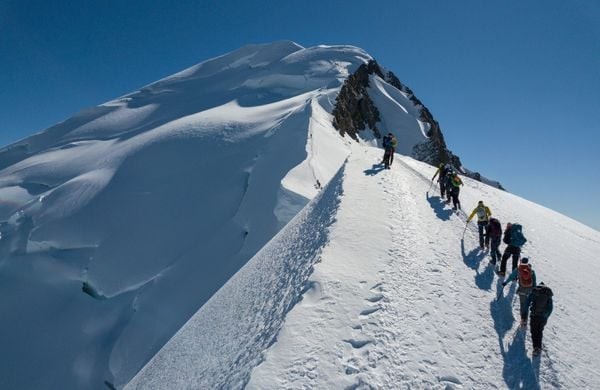Mont Blanc, the “monarch of mountains,” stands as the highest peak in Western Europe, beckoning mountaineers from around the globe. Its glaciated beauty and relative accessibility make it an aspirational challenge for many. However, before you set your sights on the summit, a crucial question arises: Can You Climb Mont Blanc Without A Guide?
While technically permissible, attempting Mont Blanc without a guide and without significant alpine mountaineering experience is strongly discouraged and potentially life-threatening. Let’s delve into the complexities of this iconic climb and explore the factors to consider.
Mont Blanc: A Mountaineering Mecca
Located on the border between France and Italy in the Alps, Mont Blanc has long been considered the birthplace of modern mountaineering since the first ascent in 1786. Its allure has captivated poets and alpinists alike, drawing adventurers to test their limits against its formidable slopes.
The Goûter Route: A Popular Path
Among the various routes to the summit, the Goûter Route via the Dôme du Goûter is the most common. While considered the least technical, it still demands previous trekking or mountaineering experience, a head for heights, a willingness to learn, and a high level of fitness. This route, starting from Les Houches, involves traversing the Refuge de Tete Rousse and Refuge du Goûter.
Day 1: Ascent to Tête Rousse
The initial leg involves a cable car ride from Les Houches to Bellevue, followed by the Tramway du Mont Blanc to Nid d’Aigle. The hike to Refuge de Tete Rousse at 3167m takes 2-3 hours across relatively easy terrain with stunning views.
Day 2: Summit Push and Descent
An early start from Refuge de Tete Rousse leads to the challenging climb to Refuge du Goûter, involving a 700m rock face ascent near the Gouter grand couloir, notorious for rockfall. After reaching Refuge du Goûter at 3835m, crampons are essential for the glaciated slopes towards the summit, passing the Dome du Goûter and the Vallot emergency shelter. The final stretch involves navigating the exposed Bosses ridge.
Day 3: Return to Les Houches
The descent follows the same route from Refuge du Goûter back to the starting point, offering a final opportunity to soak in the alpine scenery.
Alternative Routes
Other routes exist, each with varying levels of difficulty and technical requirements:
- Trois Monts Route: A more technical climb via Mont Blanc du Tacul and Mont Maudit, requiring 1:1 guiding.
- Italian Route via the Gonella Hut: A quieter option accessible primarily in early summer.
- Grand Mulets Route: The original route, now popular for ski touring in spring.
The Difficulty Factor
Climbing Mont Blanc is not a walk in the park. While not as high as Kilimanjaro, it is significantly more technically demanding. Months of training are recommended, focusing on endurance, strength, and acclimatization. Although previous mountaineering experience isn’t strictly essential, it drastically increases your chances of a successful and safe summit.
The Case for a Guide
While legally you can climb Mont Blanc without a guide, the risks are substantial. Guides are typically members of the IFMGA (International Federation of Mountain Guides Associations), offering a high level of expertise and safety.
Dangers Abound
Mont Blanc, despite its popularity, is a serious mountain with inherent dangers:
- Rockfall: The Grand Couloir on the Goûter Route is infamous for rockfall.
- Serac Falls: Falling chunks of ice pose a significant threat.
- Crevasses: Cracks in the glacier can be hidden and deadly.
- Weather: Rapidly changing weather conditions can lead to disorientation and exposure.
- Avalanches: Unstable snow conditions can trigger avalanches.
Accidents often occur in unguided parties due to lack of experience and judgment.
Essential Gear
Adequate gear is vital:
- Mountaineering boots and crampons
- Ice axe and helmet
- Harness and carabiners
- Appropriate clothing for extreme weather
- Navigation equipment
Timing is Key
The best time to climb Mont Blanc is from late May to the end of September, coinciding with favorable weather and the opening of mountain huts. Booking hut reservations is crucial.
The Verdict
Climbing Mont Blanc without a guide is a high-stakes gamble. While experienced mountaineers might consider it, for most, the risks far outweigh the rewards. A guide provides expertise, safety, and a higher probability of a successful summit. Proper preparation, training, and adherence to expert advice are paramount, regardless of whether you choose to climb with a guide or not.
